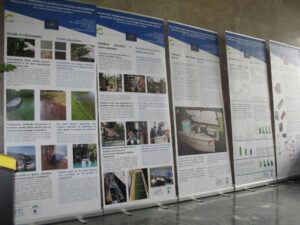Two months passed by therefore a new exhibition is set in the lobby of the Ministry of the Environment and Spatial Planning. Successors of WETMAN’s exhibition are projects LIFE PharmDegrade and LIFE Stop CyanoBloom, both coordinated by company Arhel Ltd.
As the title tells two-year project LIFE PharmDegrade – Degradation of pharmaceuticals in wastewater from nursing homes and hospitals is focusing on the problem of presence of pharmaceutical residuals in wastewaters coming from nursing homes and hospitals. In the frame of the project they have carried out initial screening on pharmaceutical residuals appearing in different wastewater sources, upgraded the analytical methods for identification and quantification of target substances in wastewater and constructed a pilot plant with a system of electrochemical oxidation for the removal of micropollutants such as pharmaceutical residuals from the water. The project, ending on 30th November 2016, is being performed by Arhel in collaboration with Faculty of Pharmacy (University of Ljubljana) and co-financed by European Commission and the Ministry of the Environment and Spatial Planning. If you are interested in project results, you are warmly invited not only visit the exhibition but to also attend the project’s closure conference, which will take place on 24th and 25th November 2016 in Ljubljana. During the conference a visit to the pilot plant will be organised.
The second LIFE project with Arhel as coordinating beneficiary is a three and a half year-long project LIFE Stop CyanoBloom – Innovative technology for cyanobacterial bloom control. Together with project partners, the Municipality of Bled and National Institute of Biology, they demonstrated for the first time in Slovenia a performance of a high-tech solution on two natural freshwater bodies in Slovenia. The technological innovation joins two things on a floating platform – a robotic vessel, an advanced sensory system with the water sampler and an electrolytic cell for prevention of cyanobacterial growth. The sensors enable detection of cyanobacteria in their early stages of occurrence as well as green algae and other environmental parameters. Stored water samples can be used for further laboratory analysis. The electrolytic cell is reduces the cyanobacteria concentration due to a system based on electrochemical activity, which triggers lysis (break down) of cyanobacteria cells. Both systems together provide a system for early detection and prevention of harmful cyanobacterial blooms without introducing chemicals or any other compounds into water bodies.
One of the last activities of the project, ending on 31st December 2016, is the closure conference, where the beneficiaries will present the results along with the demonstration of the docking station and robotic vessel operation.








